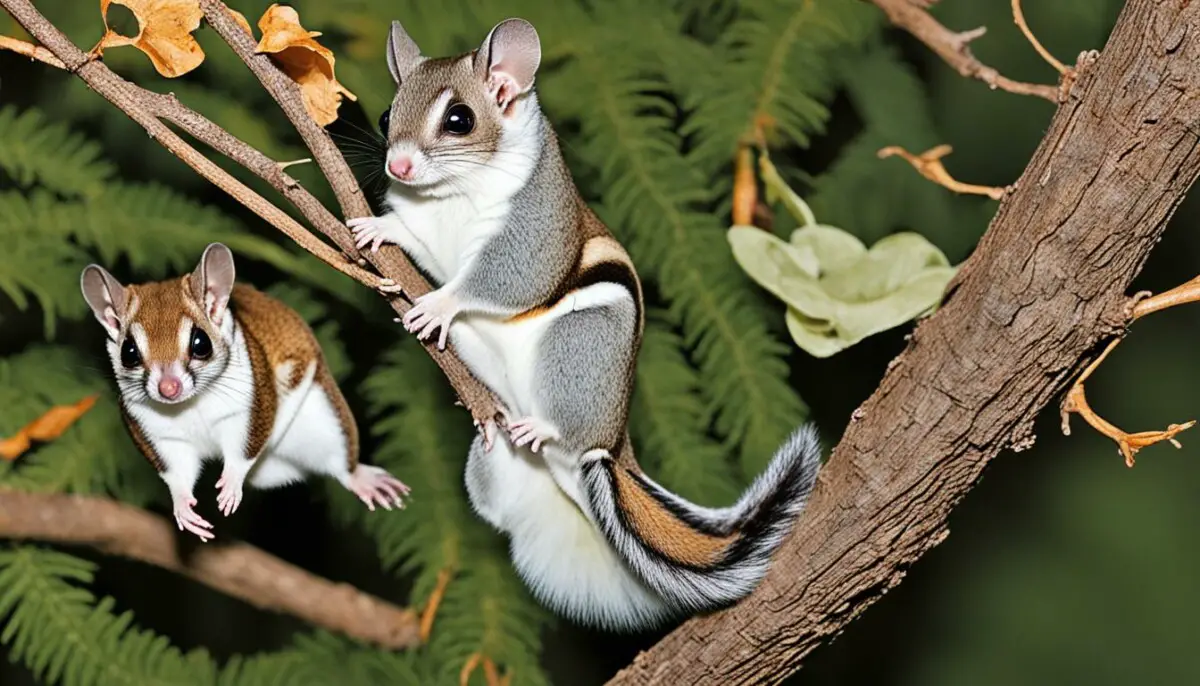Last Updated on 3 months by Francis
When it comes to small arboreal animals, flying squirrels and sugar gliders often get confused due to their similar appearance and behavior. However, they are distinct creatures with unique characteristics. In this article, we will explore the key differences between flying squirrels and sugar gliders, as well as their similarities.
Contents
Key Takeaways:
- Flying squirrels and sugar gliders may look similar, but they have distinct characteristics.
- Flying squirrels give birth to hairless newborns, while sugar gliders have pouches where their underdeveloped young crawl into.
- Sugar gliders have round faces and pink noses, while flying squirrels have pointy noses.
- Both species are adapted for arboreal locomotion, but flying squirrels are faster on the ground.
- Sugar gliders have a wider range of vocalizations, while flying squirrels make smaller sounds.
Sugar Glider vs Flying Squirrel: Reproduction and Birth
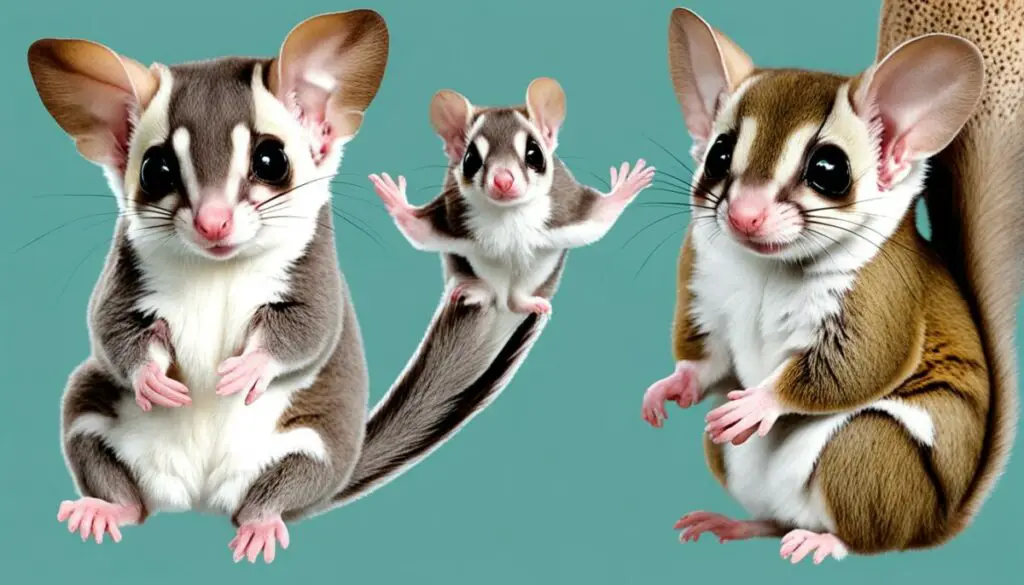
When it comes to reproduction and birth, sugar gliders and flying squirrels have distinct differences in their strategies and adaptations.
Sugar Gliders
Sugar gliders are marsupials, which means that they give birth to underdeveloped young known as joeys. After birth, the joeys crawl into their mother’s pouch, where they continue to develop and grow. The pouch provides a safe and nurturing environment for the joeys, allowing them to receive the necessary nutrients and protection.
Flying Squirrels
In contrast, flying squirrels give birth to tiny, hairless newborns that are completely dependent on their mothers. These newborns are kept in a nest, where they grow hair and teeth before they are ready to explore their surroundings. The nest provides warmth and protection for the newborns during their vulnerable early stages of life.
Overall, the reproductive strategies of sugar gliders and flying squirrels showcase their unique adaptations to ensure the survival and development of their offspring.
*Note: The image above visually represents the comparison between sugar gliders and flying squirrels in terms of reproduction and birth.*
“The reproductive strategies of sugar gliders and flying squirrels highlight their remarkable adaptations in nurturing their young, whether it’s through the mother’s pouch or the protective nest.”
Physical Differences between Sugar Gliders and Flying Squirrels
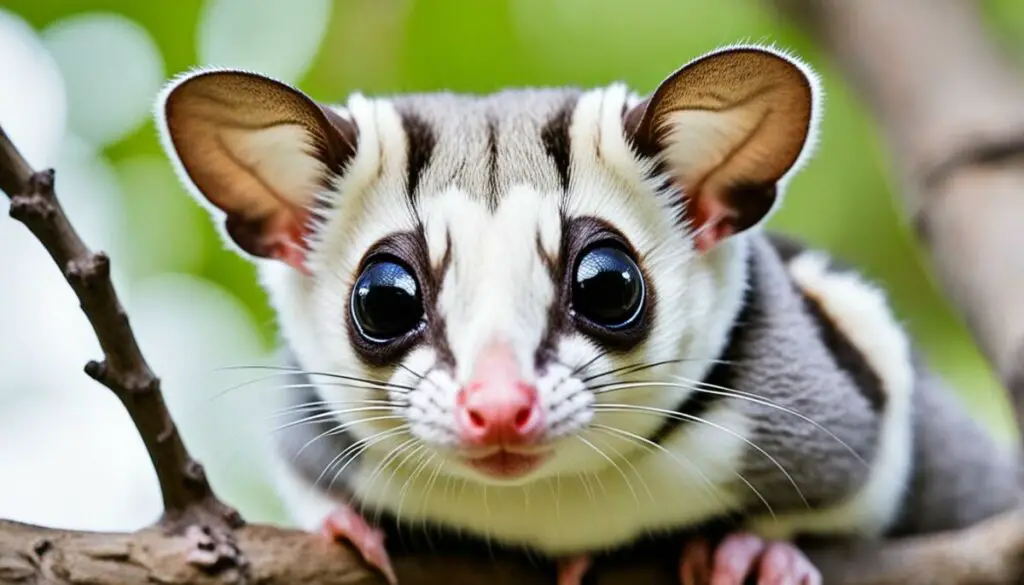
Sugar gliders and flying squirrels have distinct physical differences that set them apart. These variances can be observed in their appearance and specific body characteristics.
Sugar Glider Appearance
“Sugar gliders have round, peach-fuzzy faces and pink round noses.”
Sugar gliders are known for their cute, round faces covered in soft peach-fuzz fur. Their pink, round noses add to their adorable appearance.
Flying Squirrel Appearance
“Flying squirrels have pointy noses.”
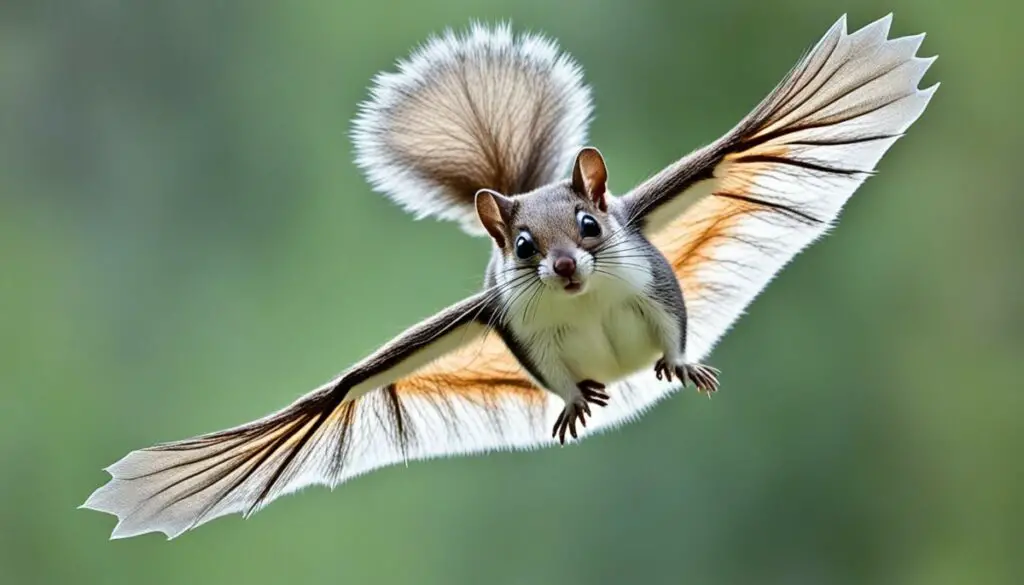
Flying squirrels, on the other hand, have distinctively pointy noses that differentiate them from sugar gliders.
Body Differences
Flying squirrels and sugar gliders also exhibit differences in their body characteristics.
- Flying Squirrel:
- Continuously growing teeth that require regular chewing.
- Typically brown and white fur coloring.
- Sugar Glider:
- Teeth that do not require the same maintenance as flying squirrels.
- Possibility of coming in a variety of colors.
These variations in physical features and body characteristics contribute to the uniqueness and diversity of these two fascinating gliding mammals.
Speed and Mobility Comparison

Flying squirrels and sugar gliders display different levels of speed and agility in their movement. Each species has adapted specific behaviors and physical characteristics to navigate their respective habitats effectively.
Flying Squirrel Behavior
Flying squirrels are renowned for their impressive speed and agility. On the ground, they can move swiftly to evade predators or find food sources. With their strong hind legs, they are capable of running at high speeds in short bursts. However, their true expertise lies in their ability to climb trees with ease, utilizing their sharp claws and powerful leg muscles.
Sugar Glider Behavior
Sugar gliders, while not as fast on the ground as flying squirrels, possess remarkable climbing and gliding abilities. They can effortlessly ascend trees using their sharp claws, allowing them to reach food sources and escape danger. But what truly sets sugar gliders apart is their unique gliding behavior. With the help of their patagium, a flap of skin stretching between their limbs, sugar gliders can glide through the air, covering impressive distances and maneuvering between tree branches with remarkable precision.
Arboreal Locomotion
Despite their different speeds and methods of movement, both flying squirrels and sugar gliders are well-adapted to arboreal locomotion. This type of locomotion involves navigating and moving through trees. These animals have developed the necessary physical attributes, such as strong limbs, sharp claws, and skillful coordination, to thrive in their tree-dwelling habitats.
| Flying Squirrel Speed | Sugar Glider Speed |
|---|---|
| Fast runners on the ground | Slower on the ground |
| Agile climbers | Excellent climbers |
| Expert gliders |
Scent and Vocalization Differences
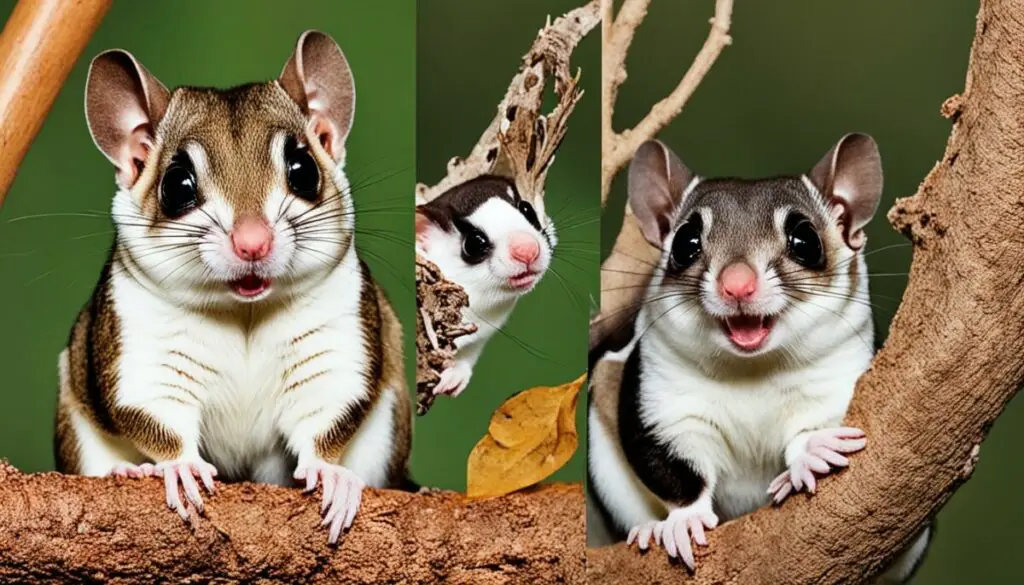
When it comes to scent and vocalizations, there are notable differences between flying squirrels and sugar gliders. These distinctions add to the unique behaviors and characteristics of each species.
Scent Marking
Sugar gliders are well-known for their strong scent and tend to scent mark more frequently than flying squirrels. This behavior is their way of establishing territories and communicating with other members of their group. On the other hand, flying squirrels have a more urine-like smell, which they may use to mark their territory as well.
Vocalizations
Sugar gliders have a wider range of vocalizations compared to flying squirrels. They can produce various sounds, from crabbing to barking, to communicate with their group or express emotions. These vocalizations serve important social and territorial functions in their natural habitats.
“Sugar gliders are capable of producing a unique range of sounds, which helps them interact with other members of their colony and express their needs and emotions.”
Flying squirrels, on the other hand, make smaller and less frequent vocalizations. They tend to produce soft squeaks or whistles, which may serve as a means of communication with other members of their colony or to ward off potential threats.
Overall, while both flying squirrels and sugar gliders have their own distinctive scents and vocalizations, sugar gliders exhibit a wider variety of sounds and scent-marking behaviors. These characteristics further contribute to the fascinating behaviors and adaptations of these small arboreal creatures.
| Flying Squirrels | Sugar Gliders |
|---|---|
| Have a more urine-like smell | Known for their strong scent |
| Produce small squeaks or whistles | Can make various sounds like crabbing and barking |
| Less frequent vocalizations | Wider range of vocalizations |
Dietary Variances
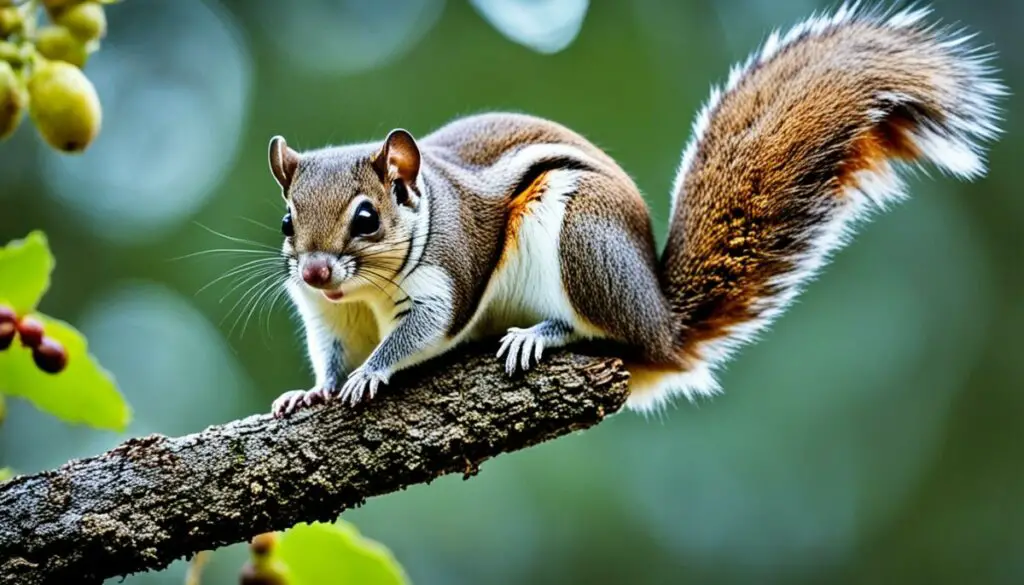
Understanding the dietary differences between sugar gliders and flying squirrels is crucial for comprehending their unique adaptations and ecological niches.
Sugar Glider Diet
Sugar gliders are omnivores, meaning they consume a variety of foods from both plant and animal sources. However, their diet is primarily fruit-based. Fruits such as apples, mangoes, and grapes are important components of a sugar glider’s daily nutritional requirements.
In the wild, sugar gliders also feed on nectar, sap, and tree gum, which provide them with essential sugars and carbohydrates. Additionally, they may consume small insects and even baby birds or rodents, although these items make up a small portion of their overall diet.
Sugar gliders have adapted to their fruit-based diet by developing sharp, pointed teeth that are ideal for piercing the skin of fruits and extracting the juicy pulp inside.
Flying Squirrel Diet
As rodents, flying squirrels have a nut/plant-based diet. Their primary source of nutrition comes from various nuts, seeds, and tree bark. Acorns, hickory nuts, and pine nuts are common dietary staples for these agile creatures.
In addition to nuts, flying squirrels may also consume a variety of edible plant materials, including leaves, flowers, and fungi. These food sources provide them with the necessary proteins, fats, and carbohydrates required for their active lifestyles.
Flying squirrels have adapted to their nut/plant-based diet by developing strong jaws and continuously growing incisor teeth. This adaptation allows them to chew through tough nut shells and extract the nutritious contents inside.
By examining their diet, we can see how sugar gliders and flying squirrels have evolved to thrive in their respective habitats. The fruit-based diet of sugar gliders reflects their adaptation to arboreal environments, where fruits are abundant. On the other hand, the nut/plant-based diet of flying squirrels highlights their ability to forage and navigate through trees to find their preferred food sources.
| Sugar Gliders | Flying Squirrels |
|---|---|
|
|
Social Behavior and Bonding
Both flying squirrels and sugar gliders exhibit social behavior and have the capacity to form strong bonds with their owners or family members. However, it is crucial to note that while they can develop relationships with humans, they also require companionship from their own species for their overall well-being, health, and happiness.
Flying squirrels, known for their sociable nature, often live in colonies or groups. They engage in various social activities such as grooming, playing, and even communal nesting. These interactions within their species are essential for communication, establishing hierarchies, and providing comfort and security.
Sugar gliders, on the other hand, have a similar inclination for socialization. They naturally form close bonds within their family groups and communicate through a range of vocalizations and body language. These interactions are vital for their emotional well-being and help them navigate their complex social dynamics.
“The social behavior of flying squirrels and sugar gliders highlights their innate need for social connections and companionship for their overall happiness and health.”
While it is possible for both flying squirrels and sugar gliders to bond with humans, it is important to understand that these animals thrive best when they have the opportunity to interact and socialize with their own species. Bringing them into a home environment should always include considerations for providing opportunities for socialization with their own kind.
By respecting their social needs and facilitating their natural behaviors, owners can ensure the well-being and contentment of their pet flying squirrels or sugar gliders.
Housing and Enclosure Requirements
When it comes to housing and enclosure requirements, both flying squirrels and sugar gliders have specific needs to ensure their well-being and happiness. As arboreal animals that naturally live in trees, providing them with tall enclosures that allow for climbing and short hops is essential.
A medium-sized birdcage can be a suitable option for both flying squirrels and sugar gliders, as it provides the necessary space for them to move around comfortably. Ensure that the cage has horizontal bars to allow for climbing and attaching toys or branches for enrichment.
It’s important to create a stimulating environment for these animals by including platforms, hammocks, and ropes for climbing and exploring. Offering nesting material, such as soft fabric or shredded paper, will provide them with a cozy place to rest.
Additionally, placing the enclosure in an area with plenty of natural light and away from drafty spaces is crucial for their well-being. Consider placing their cage near a window with a view of nature to mimic their natural habitat.
Remember to regularly clean the enclosure to maintain proper hygiene and prevent the buildup of odors. Providing a consistent temperature within their habitat, preferably between 70-80°F (21-27°C), will help keep them comfortable.
Comparison of Housing and Enclosure Requirements
| Flying Squirrels | Sugar Gliders |
|---|---|
| Require tall enclosures for climbing | Require tall enclosures for climbing |
| Medium-sized birdcage is suitable | Medium-sized birdcage is suitable |
| Horizontal bars for climbing | Horizontal bars for climbing |
| Platforms, hammocks, and ropes for enrichment | Nesting material for a cozy resting place |
| Placed in an area with natural light | Placed in an area with natural light |
| Regular cleaning to maintain hygiene | Regular cleaning to maintain hygiene |
| Consistent temperature (70-80°F, 21-27°C) | Consistent temperature (70-80°F, 21-27°C) |
Nocturnal Lifestyle
Both flying squirrels and sugar gliders are nocturnal animals. This means they are most active during the night and sleep during the day. The nocturnal behavior of these fascinating creatures is driven by their natural adaptations, allowing them to thrive in their respective habitats.
This behavior serves multiple purposes, including avoiding predators and finding food. By being active during the night, flying squirrels and sugar gliders reduce their chances of encountering predators, as many of their main threats are diurnal (active during the day). The cover of darkness provides them with a level of protection and security.
Flying squirrels and sugar gliders also take advantage of the darkness to hunt for food. Many of their food sources, such as insects, fruits, nectar, and tree sap, are more abundant at night. By being nocturnal, these animals have a competitive advantage when it comes to foraging, as they can access food resources that are not available during the day.
The nocturnal lifestyle of flying squirrels and sugar gliders is intricately tied to their behavior and characteristics. It is a key aspect of their survival in the wild and showcases their incredible adaptations to their environments.
“The night offers these amazing animals an opportunity to thrive, evading predators and securing the nourishment they need.”
Conclusion
While flying squirrels and sugar gliders may have some similarities, such as their gliding abilities and nocturnal behavior, it is important to recognize that they are distinct animals with unique characteristics and adaptations. Understanding the differences between these fascinating creatures can help us better appreciate and care for them.
Flying squirrels and sugar gliders differ in their reproductive strategies. Sugar gliders are marsupials, giving birth to underdeveloped young that continue to develop in their mother’s pouch. In contrast, flying squirrels give birth to tiny, hairless newborns that are kept in a nest before growing fur and developing teeth.
Physical differences can also be observed between the two species. Sugar gliders have round, peach-fuzzy faces and pink round noses, while flying squirrels have pointy noses. Additionally, sugar gliders can come in a variety of colors, while flying squirrels are typically brown and white. These distinctions contribute to their unique appearances.
Despite these differences, both flying squirrels and sugar gliders share interesting characteristics. They are both adapted for arboreal locomotion, with the ability to glide through the air. Both species are also nocturnal, being most active during the night. These shared traits highlight their incredible adaptability and survival strategies.
In conclusion, by understanding the differences and similarities between flying squirrels and sugar gliders, we can gain a deeper appreciation for these remarkable creatures and provide the best care possible for them in captivity or in their natural habitats.
FAQ
What are the key differences between a flying squirrel and a sugar glider?
Flying squirrels and sugar gliders have differences in their reproduction and birth strategies, physical appearances, speed and mobility, scent and vocalizations, dietary preferences, social behavior and bonding, housing and enclosure requirements, and nocturnal lifestyle.
How do flying squirrels and sugar gliders differ in terms of reproduction and birth?
Sugar gliders are marsupials that give birth to underdeveloped young that crawl into their mother’s pouch for further development, while flying squirrels give birth to tiny, hairless newborns that are kept in a nest until they grow hair and teeth.
What are the physical differences between sugar gliders and flying squirrels?
Sugar gliders have round faces with pink round noses, while flying squirrels have pointy noses. Additionally, sugar gliders can come in various colors, while flying squirrels are typically brown and white. Sugar gliders have teeth that do not require regular maintenance, whereas flying squirrels have continuously growing teeth that need to be regularly chewed.
How do sugar gliders and flying squirrels differ in terms of speed and mobility?
Sugar gliders are slower on the ground but can climb trees and glide through the air like flying squirrels. Flying squirrels, on the other hand, are known for their quickness and agility on the ground and in tree climbing.
What are the scent and vocalization differences between sugar gliders and flying squirrels?
Sugar gliders have a stronger scent and scent mark more often compared to flying squirrels. Flying squirrels, on the other hand, have a more urine-like smell. Sugar gliders produce a wider range of sounds, from crabbing to barking, while flying squirrels make smaller, less frequent noises like squeaks or whistles.
What are the dietary preferences of sugar gliders and flying squirrels?
Sugar gliders are omnivores and primarily eat a fruit-based diet, while flying squirrels, being rodents, have a nut/plant-based diet.
Both species exhibit social behavior and can bond with humans, but they require the companionship of their own species for optimal health and happiness.
What are the housing and enclosure requirements for sugar gliders and flying squirrels?
Both sugar gliders and flying squirrels are arboreal animals that naturally live in trees. They require tall enclosures that allow for climbing and short hops. A medium-sized birdcage can be suitable for both species.
Do sugar gliders and flying squirrels have a nocturnal lifestyle?
Yes, sugar gliders and flying squirrels are nocturnal animals, meaning they are most active during the night and sleep during the day.
What are the similarities and differences between flying squirrels and sugar gliders?
While flying squirrels and sugar gliders share some similarities, such as gliding abilities and nocturnal behavior, they have distinct differences in various aspects of their characteristics, adaptations, and behaviors.

